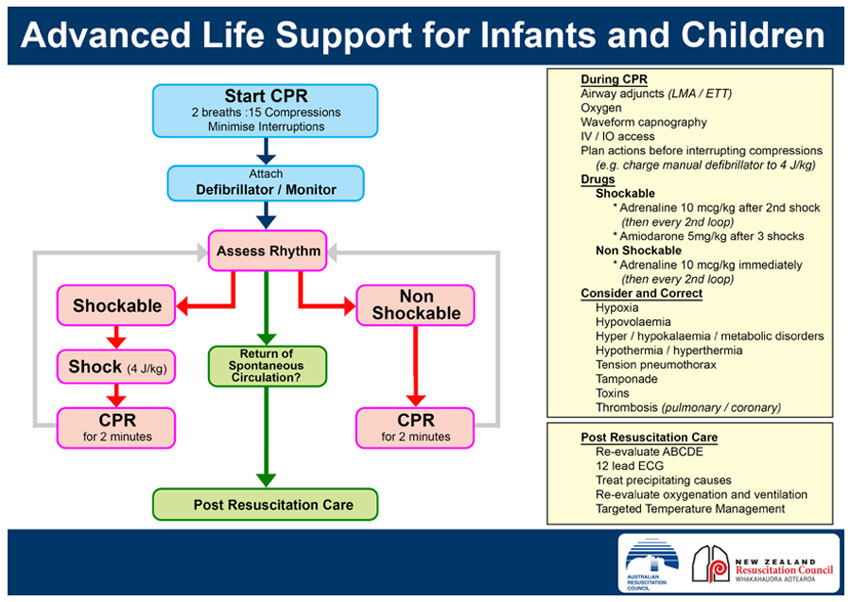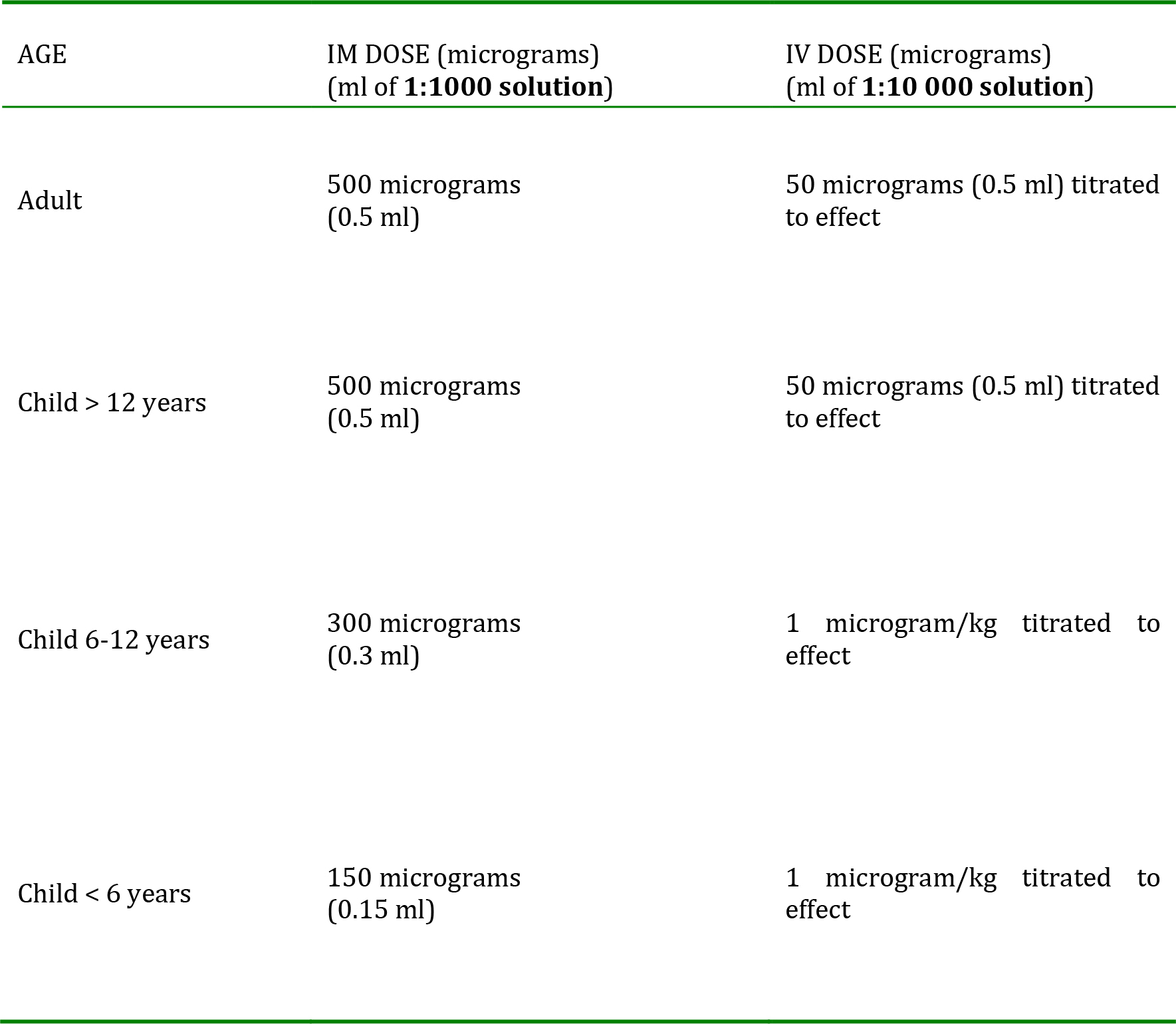If absent commence basic life support or appropriate cardiopulmonary resuscitation CPR as per the Australian Resuscitation Council guideline. ALWAYS use adrenaline autoinjector FIRST in someone with known food allergy who has.

Clinical Practice Guidelines Resuscitation Hospital Management Of Cardiopulmonary Arrest
1

Duration Of Cpr And Doses Of Epinephrine Download Table
40 units of vasopressin IVIO push may be given to replace the first or second dose of epinephrine and at this time there is insufficient evidence for recommendation of a specific dose per the endotracheal tube.

Adrenaline dose in cpr. CPR when trying to get. Commence CPR if there are no signs of life 3. Keep giving adrenaline every 5 minutes until the ambulance arrives if their condition does not improve.
Dose according to the persons weight. Adrenaline is a hormone released from the adrenal glands that prepares the body for fight-or-flight. When you hear your lead say Give 05mg of epinephrine during a cardiac arrest you may correct the lead saying I have heard an order of 05mg of epinephrine but i think the correct dose is 1mg.
5 mg intravenous bolus NOTES. All others are synthetically derived. One of the main objects of this team member is to call out each time a patient receives a dose of epinephrine record the time and then alert the team when it is time for the next dose should it be required.
Adrenaline has been used in the treatment of cardiac arrest for many years. Withdrawal of CPR The decision to withdraw CPR in children is difficult and must involve experienced senior clinicians who will consider the clinical context and the desires of patient and family. It is given intravenously by injection into a muscle.
Give oxygen by face mask at a high flow rate if available. Adrenaline works by narrowing the blood vessels to counteract the effects of low blood pressure and opening up the airways to help ease breathing difficulties. Adrenaline is injected into the muscle of the outer mid-thigh that is midway between the knee and hip joints on the outer side of the thigh using an adrenaline autoinjector EpiPen.
A repeat dose of intramuscular adrenalineepinephrine should be given after a 5-minute interval if there is no improvement in the patients condition. Commence CPR at any time if the person is unresponsive and not breathing normally. If their condition has not improved after 5 minutes give another dose of 11000 adrenaline.
Phone parentemergency contact 4. You may correct a colleague politely. Adrenaline 1mg 10 ml 110000 as a prefilled syringe x 3 Immediate.
Levophed is similar to adrenaline. Subsequent doses of adrenaline are given every 35 minutes. Levophed may also be used for purposes not listed in this medication guide.
Medical emergencies can occur in the dental practice. The recommended IVIO dose of adrenaline in children is 10 mcg kg-1 01mL kg-1 of 1 in 10000 solution. The posters Medical Emergencies in the Dental Practice and Emergency Drugs in the Dental Practice have been designed to help dental care.
If there is no spontaneous circulation 20 minutes after cardiac arrest then the chance of recovery is essentially zero. It is possible that better short-term survival comes at the cost of worse long-term outcomes. Fully document the event including the time and doses of adrenaline given.
Epinephrine also known as adrenaline is a medication and hormone. Local anesthetics produce anesthesia by inhibiting excitation of nerve endings or by blocking conduction in peripheral nerves. In the ACLS pulseless arrest algorithm vasopressin may replace the first or second dose of epinephrine.
For the next hour and decreasing to a maintenance dose of 1-2 mg per minute thereafter If patient is unresponsive or if Lignocaine is contraindicated. Hysterical strength is a display of extreme strength by humans beyond what is believed to be normal usually occurring when people are in life-and-death situationsThe classic anecdotal example is of parents lifting vehicles to rescue their trapped children. This narrative review summarises the rationale for using adrenaline.
Anaphylaxis may occur without initial mild signs. The papers published deal with the aetiology pathophysiology and prevention of cardiac arrest resuscitation training clinical resuscitation and experimental resuscitation research although papers relating to animal studies will be published only if they are of exceptional interest and related directly to. Resuscitation is a monthly international and interdisciplinary medical journal.
Adrenaline should be the first line treatment for anaphylaxis in pregnancy and prompt administration of adrenaline 11000 IM adrenaline 001mg per kg up to 05mg per dose should not be withheld due to a fear of causing reduced placental perfusion. Cocaine a compound indigenous to the Andes Mountains West Indies and Java was the first anesthetic to be discovered and is the only naturally occurring local anesthetic. This medicine is often used during CPR cardio-pulmonary resuscitation.
Give high dose adrenaline eg. For shockable rhythms give the initial dose of adrenaline immediately after the third shock and then after alternate shocks 5 th 7 th 9 th etc. If no improvement after 5 minutes give a further dose of adrenaline using another autoinjector device if available.
During a cardiopulmonary resuscitation CPR attempt there is often a nurse assigned to record the dose and time of each medication administered. 1mg needed for each 4-5 min of CPR Amiodarone 300mg as a prefilled syringe x 1 Accessible. Other treatments in anaphylaxis.
Adrenaline injection is used to treat anaphylaxis. First dose required after 3 defibrillation attempts. IV adrenaline boluses cardiac arrest dose 1mg every 2-3 mins and aggressive fluid resuscitation may be required in addition to CPR follow cardiac arrest protocol.
So that patients can slowly build up to an effective dose while still getting some immediate relief from adrenaline stress anxiety. Epinephrine should be rapidly administered to a newborn through the umbilical vein if the heart rate has stayed below 60 beats per minute after 30 seconds of assisted ventilation. Transfer all cases to hospital for further observation and treatment.
Epinephrine also known as adrenaline is a hormone and neurotransmitter and produced by the adrenal glands that can also be used as a drug due to its various important functionsThough it has long been used in the treatment of hypersensitivity reactions epinephrine in the auto-injector form EpiPen has been available since 1987 in the USA. Patients who have no improvement in respiratory andor cardiovascular problems despite 2 appropriate doses of intramuscular adrenalineepinephrine should have their care escalated quickly and managed as having refractory anaphylaxis. It may also be used for asthma when other treatments are not effective.
The extra strength is commonly attributed to increased adrenaline production though supporting evidence is scarce and inconclusive. Youll be given an auto-injector of adrenaline to use in case of emergencies if you or your child is at risk of anaphylaxis or had a previous episode of anaphylaxis. It is used to treat life-threatening low blood pressure hypotension that can occur with certain medical conditions or surgical procedures.
What if you think the team lead gave a wrong dosage and you know the right dose. Number of syringes depends on access to further syringes. As a medication it is used to treat a number of conditions including anaphylaxis cardiac arrest asthma and superficial bleeding.
Epinephrine or adrenaline increases blood pressure and stimulates the heart. Inhaled epinephrine may be used to improve the symptoms of croup. It increases the likelihood of return of spontaneous circulation ROSC but some studies have shown that it impairs cerebral microcirculatory flow.
Antihistamines have no role in treating or preventing.

Time To Administration Of Epinephrine And Outcome After In Hospital Cardiac Arrest With Non Shockable Rhythms Retrospective Analysis Of Large In Hospital Data Registry The Bmj
2

Cpr For Dogs And Cats The Recover Guidelines

Paediatric Resuscitation Resus

Part 7 Adult Advanced Cardiovascular Life Support Circulation

Adrenaline Epinephrine Anaesthesia Tutorial Of The Week 226 Wfsa Resources

Pulmcrit Epinephrine Vs Atropine For Bradycardic Periarrest

A Comparison Of High Dose And Standard Dose Epinephrine In Children With Cardiac Arrest Nejm

